Conspiracy X: Second Edition by Fossilized Rappy
Indoctrination
Original SA post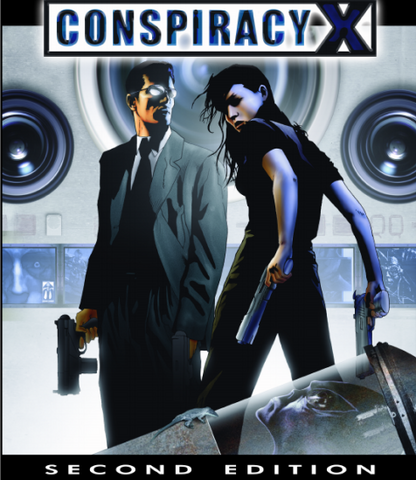
Conspiracy X Second Edition Back Cover posted:
You wake up in the morning and get the feeling that something isn't as it should be. Why do certain figures appear out of nowhere and become famous overnight? Why do the rich get richer, and the poor get poorer? What is the government really paying for when it shells out 75 bucks for a screwdriver? Why is it the more questions you ask the less answers you get? Why is it any answer always leads to another question?
I promised I'd get to this title near the start of the year, and neither snow, sleet, hail, nor crushing depression could hold me back forever. And now, here we are, Conspiracy X, a setting that's been around the block a few times. First came Conspiracy X, the startup project of Eden Studios back in 1996. It utilized a system that was more or less the evolutionary ancestor of the Unisystem engine, with less condensed skills, more attributes, and generally a bit more chunkiness to it. It was popular enough to get twelve sourcebooks, with names such as The Hand Unseen, Atlantis Rising, and Bodyguard of Lies: Mokole. In 2002, there was also a GURPS Third Edition version of Conspiracy X released, which as far as I know is the only GURPS title that has been (and still is) sold firsthand outside of Steve Jackson Games's storefront.
Finally, you have Conspiracy X Second Edition, the title I'm here to throw at you for your entertainment. This title was released in 2006 and unified Conspiracy X into the rest of the Eden Studios stable by making it run on Unisystem. After a gap of five years, most of the material from the first edition ended up snaking its way into three further sourcebooks all funded through Kickstarter: The Extraterrestrials Sourcebook covered the original sourcebooks on the Atlanteans, Grays, and Saurians (the three alien races of the setting), The Paranormal Sourcebook condensed the first edition's supplements on psychics, arcane powers, and monsters from cryptozoology, and The Conspiracies Sourcebook revamped material on Aegis, Black Book, and the build-your-own-conspiracy book Sub Rosa. You may notice this leaves three books out; those would be the Bodyguard of Lies trilogy, which I may cover in the future as a little aside.
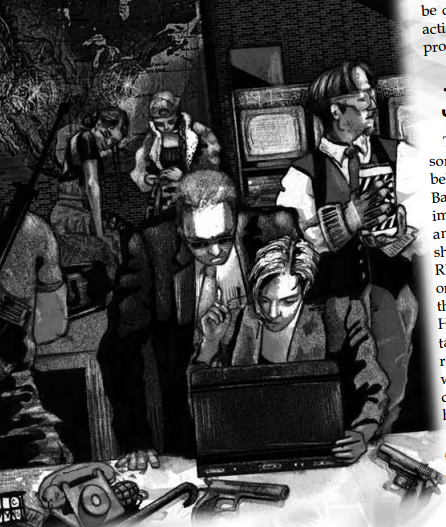
Chapter 1: Indoctrination
Since the first chapter of the book is also the introduction chapter, I figured I'd roll it in with this introductory post rather than separate it into its own thing. First is a basic overview of the standards the book uses. You've got the Unisystem and its use of the d6, d8, and d10, all measurements are Imperial but the basics of conversion to metric are noted as a nice little gesture to different countries, and the book flips between male and female pronouns each chapter because Eden Studios felt that Wizards of the Coast's "he or she" was too clunky and the singular they wasn't really en vogue back in the Bush years. There's also the whole "what is roleplaying?" spiel, with the metaphor of it being like playing make believe but with some rules to keep everything on the rails. In Conspiracy X, he Game Master equivalent is referred to as the Chronicler and players are referred to as Cast Members. I'll probably still call them GM and players in this review anyway, because I'm stubborn that way.
The central premise of Conspiracy X is that the world is truly and distinctly Fortean in nature once you peer behind the curtain of lies: Lizard people are trying to rule the world, little Gray men crashed in Roswell, Hitler was a wizard who also had his scientists build flying saucers, psychic operatives helped Lee Harvey Oswald aim his shots from the grassy knoll, the Illuminati is real and run by Atlanteans, etc. etc. You even have werewolves and vampires, though probably not in the way you'd think. Not so different from a lot of The X-Files or such, right?
Well, the big thing here is that you are part of the conspiracy. The core rulebook assumes that you are going to be part of Aegis, an anti-extraterrestrial secret government agency that is in a backstage cold war with Black Book, another secret society that is embedded in the American military and has decided to work with the aliens rather than against them. You aren't the Mulder here; no, you get to be the Cigarette-Smoking Man, including all the grim and morally gray duties that may entail. Of course, just because you are part of the conspiracy doesn't mean you are cleared for all of the answers:
Conspiracy X Second Edition posted:
To keep the “Truth,” as well as the full details and rules for the paranormal and alien races, completely out of sight of the players, separate sourcebooks have been created. The first two books, The Extraterrestrial Sourcebook and The Paranormal Sourcebook, detail all the alien motivations and plans, as well as rules for powerful psychics, magical rituals, and corrupted monsters. This information is to be parceled out by Chroniclers as the campaign progresses, if at all. Hints of the “Truth” are covered in the later chapters of this book, as are sample alien characters and paranormal powers, so that Chroniclers can run fully realized games without purchasing the other books. The details in this book, however, only touch the surface of the lies, cover-ups, and supernatural horrors that await the unsuspecting agent.
In some games one might be tempted to refer to this as GM adversarialism, but it makes sense to have that kind of secrecy in a game where part of the point is that you don't know deep the rabbit hole goes and are supposed to find out yourself. That and there are a lot of parts of the narrative that are meant to be malleable depending on what the GM and players are most comfortable with (more on that when we get to the 9/11 sidebar later on). Indeed, a big thing the introductory chapter here emphasizes is that you should play the game in a way that the players have fun, not necessarily in a way that is the most by the books. Some of the recommended media include Freakylinks, The X-Files, Twin Peaks, Akira, 24, and Hong Kong action films, to give you an idea of how varied they want you to be able to play the setting.
Next Time: Does this all sound crazy? Good, because that means I'm at least not totally incompetent in conveying how it feels to look at this setting. With the intro out of the way, it's on to the meat with the first portion of Chapter 2.
Personnel
Original SA post
Chapter 2: Personnel
Recruitment
Congratulations, you're an Aegis agent! Through some manner of happenstance, you learned the Truth and were considered useful enough to be drafted into the organization's shadow war against Black Book, or the National Defense Directorate as it is officially known. Soon after the end of World War II, three alien species made themselves known to a select few, and from this event the two organizations were born. Why did the aliens come at that time, and why have they made an alliance with Black Book?
 , but Aegis is sure that whatever the aliens' plans are can't be good. After all, the government infiltration, abductions, and sometimes hostile actions don't seem to be some good will operation. As for Black Book, the Aegis leadership feels that they have made a deal with the devil, as it were, and that their schemes will eventually fall back on them in a horrible way. Until that time comes, the two groups shall continue their war with each other in the shadows.
, but Aegis is sure that whatever the aliens' plans are can't be good. After all, the government infiltration, abductions, and sometimes hostile actions don't seem to be some good will operation. As for Black Book, the Aegis leadership feels that they have made a deal with the devil, as it were, and that their schemes will eventually fall back on them in a horrible way. Until that time comes, the two groups shall continue their war with each other in the shadows.As an Aegis agent, you are part of a specific cell made up of several other agents. Cells are not allowed to communicate with other, or even learn of each others' identities. You could be living a few doors down from another Aegis agent from a different cell and never even know it, which is an intentional attempt to heighten security and "keep operatives on their toes". The only ones who get to know everything are your bosses in the organization hub known as Aegis Prime, who are contacted through a special computer network called HERMES. Each agent has a HERMES link, which resembles a cell phone or PDA and contains a digital camera, vid and audio recorders, walkie-talkie, uber-wifi, GPS, satellite uplink, and access to the HERMES database. The link has special safeguards to identify the user, insanely high levels of encryption, and failsafes that blow the unit to hell if anyone tries to tamper with it. Agents are expected to give detailed reports on all actions and findings in the field, as well as keep everything in utmost secrecy.
Aegis's agency of secrecy is referred to as the Bodyguard of Lies, referring to the Winston Churchill quote "in wartime, truth is so precious that she should always be attended by a bodyguard of lies". Their reasoning is that telling everyone that the planet is being invaded by aliens who either look human, can make themselves look human, or can simply mind control humans to do their bidding might lead to a liiiiittle bit of civil unrest on a global scale. Furthermore, while the leaders of Aegis feel that the American government is corrupt and incompetent at best, they also realize that a known variable is much safer to deal with than a new wild card. Agents are expected to lie, defame, forge, and even kill to keep the truth a secret until the war is won.
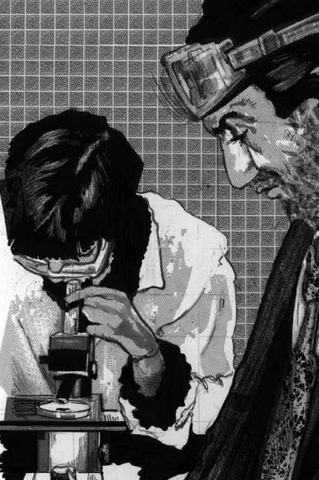
Character Creation
As a Unisystem game, characters in Conspiracy X have six "parts" that make up the greater whole: Character Type, Profession, Attributes, Qualities/Drawbacks, Skills, and Finishing Touches. While there have been wonderful previous reviews of Unisystem titles such as Buffy the Vampire Slayer and All Flesh Must be Eaten, I'll cover the bases anyway as some of it is different here and because not everyone wants to go back and look for another review just to understand the one they're currently reading.
Character Type is your "power level", and determines how generous the point buy is for you. All characters get to take up to 10 points in drawbacks, but beyond that their point allocation is dependent on their character type. Pre-Heroic characters are average Joes who are going into the world of Conspiracy X with the same general chance of survival and sanity as your average Call of Cthulhu character. They get 15 Attribute points, 5 Quality points, and 30 Skill points. Neo-Talented are almost average Joes, other than the fact that they get psychic or magic powers. They are almost the same point buy-wise as Pre-Heroics, save for allocating 5 Skill points to 5 points for Powers (magic and psychic funtime stuff). Heroic characters are cinematic martial artists, action heroes, and other people who aren't meat grinder material. They get 20 Attribute points, 15 Quality points, and 35 Skill points. Their supernatural equivalent is the Talented, which allocates 15 of those points they would have put into Skills into Powers instead.
Your Profession is more or less a prepackaged set of Qualities, Drawbacks, Skills, and Pulling Strings (more on that in a moment) based on a specific job. They usually only take a small chunk of your available points, as your job is only part of who you are.
Attributes come in six flavors, as per the typical standard for such things in roleplaying games. Strength is your physical power and reflects how much damage you can both give and take, Dexterity is coordination and how well you can aim your hits, Constitution is your immune system and physical endurance, Intelligence is your memory and learning ability, Perception is your five senses, and Willpower is your self-control and mental resistance. A score of 1 in an attribute means you are below average, 2 is average, 3 is above-average, 4 is very good, 5 is almost the best, 6 is the absolute limit for average human beings, and 7 or higher is superhuman. You also have four secondary attributes, affected by certain primary attributes and a x2 or x3 multiplier: Life Points are your HP bar and are affected by Strength and Constitution multiplied by four and given 10 more points, Endurance Points are your Fatigue Points by any other name and are your Constitution, Strength, and Willpower multiplied by three and then given 5 further points, Speed is your maximum movement and is your Constitution and Dexterity doubled, and Essence is your character's soul/life energy and given a total by the sum of all your attributes bundled together.
Qualities and Drawbacks are the system's form of advantages and disadvantages. Most of your character traits that aren't learned skills are gonna be in here. Most Qualities and Drawbacks are classified as either physical, mental, social, or paranormal traits. There is one exception, however: Pulling Strings. Pulling Strings is a special form of Quality that you can get for free from your Profession or being in with specific groups, though you can optionally buy Pulling Strings that you don't normally have access to as well. Most Strings you can Pull are some sort of legal enforcement or criminal favor.
Skills are all the tasks your character can train or learn to make better. Like Attributes, Skill points in Conspiracy X are mostly on a 1 to 5 scale, with 1 being a rank amateur and 5 being exceedingly competent. Anything higher means you are crazy-expert at that skill and it comes to you as second nature.
Finally, Finishing Touches is the term for all of your character sheet filler. That's your character's name, appearance, age, and gear.

Profession List
The list of Professions you can take is lengthy and has wide as hell coverage, with two or more Professions for pretty much every branch of the government. And I do mean every. ATF, BDS, BOP (with Professions from both the wardens and the prisoners), CDC, CIA, DIA, DTIC, FBI, ICE, NASA, NSA, and a veritable Campbell's can of other alphabet soup organizations are all here, as well as all the branches of the military since even Black Book can't recruit every single soldier out there. Rather than go over a remedial lesson on what immigration agents, border control, and federal agents do, I'm going to talk about the government organizations Aegis draws from that don't exist in the real world, especially since this is where we first start getting a look at some of the wild things that the secret world gets up to.
Center for Advanced Phenomenological Studies: A huge security breach and loss of personnel in 1967 courtesy of a cabal known as the Montague Club was a shocking wakeup call for Aegis. Turns out that having no wizard insurance is a horrible idea! An occultist by the name of Peter Henry Westmane came to Aegis Prime out of the blue, claiming that not only did his mystics have ties to the organization that preceded Aegis, but could also solve the whole Montague Club problem. And solve it they did, with Westmane and a squad of spies and soldiers provided to him neutralizing almost all of the Montague Club in just a year. Aegis quickly offered Westmane a research facility at Nellis Air Force Base and funding for further study of the paranormal. While he knew full and well that Aegis had the ulterior motive of wanting to keep a potentially dangerous variable under their thumb, Westmane accepted the offer, and CAPS was born.
There are four Professions for CAPS characters: the CAPS Field Explorer is an archaeologist and anthropologist with a specialization in occult history, the CAPS Occultist studies the paranormal-producing phenomenon known as the Seepage and has learned how to manipulate it through magic rituals, the CAPS Parapsychologist studies a wide range of supernatural events but doesn't have the ritual knowledge of the Occultist, and the CAPS Psychic is trained to use their psychic powers to find information by any means necessary.
Project CYGNET and Project GRAYBEARD: Two covert government projects to enhance warfare through psionic means; CYGNET specializes in clairvoyance, while GRAYBEARD focuses on telepathy and telekinesis. CYGNET operatives are assigned to a secondary agency that they spy for, which can be any group other than CAPS, MKULTRA, or Project Rasputin, while GRAYBEARD operatives have no other allegiance (besides Aegis, of course). The other big thing that CYGNET has going for it is that its agents have access to THOTH, a remote viewing-enhanced supercomputer that can access the files of the NSA, CIA, and HERMES alike. CYGNET gets the Professions CYGNET Remote Viewer (a psychic specializing on spying through clairyovance) and CYGNET Scientist/Parasychologist (the nerds who get no psychic powers but have more knowledge skills), while GRAYBEARD gets the GRAYBEARD Operative (a more traditional secret agent who happens to also get psychic powers).
MKULTRA: In the fantasy world of Conspiracy X, not only did MKULTRA actually succeed in making psychics via LSD and other chemical substances, they also survived past the 50s by being transferred from the CIA to Aegis. While MKULTRA agents are some of the best psychics in the business, they are also kind of messed up in the head from all the drugs they take, and most other Aegis agents tend to be a bit nervous around them. The Professions this group gets are the MKULTRA Operative (the drug-fueled psychics who also know how to stalk and kill you), MKULTRA Psychic (the drug-fueled psychics who won't stalk and kill you but might just break your brain because they were told to get some important intel out of it), and MKULTRA Scientist/Parasychologist (the guys who make the drugs and train the psychics).
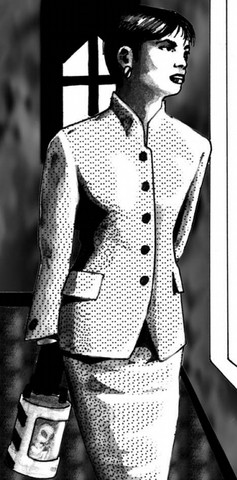
Project MOONDUST: Remember Project BLUEBOOK, the real world study on UFOs by the Air Force? Well, in the world of Conspiracy X, the reason that it never had any conclusive findings is that these guys snipped out all the real info first. MOONDUST takes part in what is more or less a XCOM's UFO missions, securing and cleaning up downed alien craft. MOONDUST also has a public face called BLUE FLY, which acts as a disinformation group by dressing up alien crash sites as foreign planes or satellites that were downed on US soil. MOONDUST operatives get a surprising five different Professions, with the MOONDUST Linguist (codebreakers and alien language specialists), MOONDUST Ops Specialist (the planners and safety team members) MOONDUST Tech Specialist (the guys that secure the tech and clean up the evidence after Ops makes everything safe), MOONDUST NAIC Technician/Engineer (scientists that study and reverse-engineer alien tech), and MOONDUST BLUE FLY Pilot (the one who flies the ship).
The Ranch: The Ranch is a major Aegis base of operations, located in the famed Groom Lake facility in Nevada. Research from other portions of Aegis filter into the secret parts of the base to help create new and better technology as well as dissect and study alien biology, while regular military operations act as a smokescreen. The two Professions for Ranch members is Ranch Scientist/Technician (most of the same stuff as other Scientist/Technician professions, just with access to the Ranch's toys) and Ranch Test Pilot (test pilots crazy enough to fly highly unsafe and experimental jet fighters created with reverse-engineered extraterrestrial technology).
Project Rasputin: Originally funded by Stalin to create Soviet psychics to fight Nazi occultists in World War II and later given even greater power under Nikita Krushchev, Project Rasputin was an effort to create very powerful psychics as well as psychotronic (psi-amplifying) devices such as a psychotronic satellite meant to be operated with the aid of space station Mir. Unfortunately for the project, the fall of the Soviet Union resulted in the new Russia disowning them and most of its members either assassinated or captured by Aegis operatives. A decent number of Rasputin psychics are still working for Aegis to this very day, with an especially high concentration around the Ranch. Their Professions are the Rasputin Psychic Agent (a psychic with electronics knowhow and access to psychotrons) and Rasputin Scientist/Parapsychologist (you know the drill by now on these guys).
Next Time: How many points does it take to get to the center of a big psy-op? The rest of chapter 1 will know!
Personnel Continued
Original SA post
This post is brought to you by “my Internet finally stopped being a shit and let me upload things”.
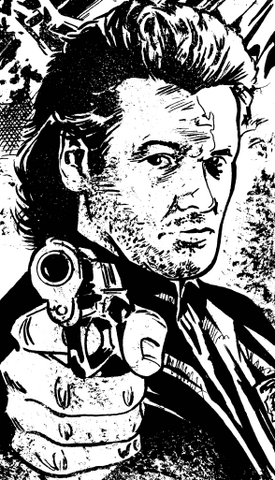
Chapter 2 Continued
Qualities and Drawbacks
As noted before, qualities and drawbacks are your standard advantage and disadvantage system, filling up the category of character traits that don't fall under either Attributes or Skills. A lot of these are self-explanatory sorts of things: Addiction, Depression, Good or Bad Luck, Hard to Kill, Minority, and the like are kind of easy to discern the purpose of by their name alone. Of course, that still leaves some of the weird and interesting ones, mostly supernatural in nature, for us to give a look at.
Abductee: Your backstory involves you being abducted by aliens. Just what that backstory's details are remain up to you and your GM, but the end result is that you get a little grab bag of abilities. On the plus side, you've got a +2 to the Myth and Legend (UFOlogy) skill and Contacts in a UFOlogy group. On the minus, you also happen to be on some alien species' radar, and not only did they learn everything about your past when abducting you, they're still keeping tabs on you even now.
Academic Outcast: Your kooky theories (that most likely happen to be true, given what this setting is) got you shunned by those darn ivory tower academics. You get a -2 to the Research/Investigation skill if you are trying to get information through conventional academic channels and you are recognized.
Atlantean Nanotech: All Atlanteans are cyborgs, utilizing nanomachines coursing through their bodies to better control their organs, give them superhuman powers, or make them into living wifi spots. Aegis happens to have a little bit of knowledge on this nanotech, and some lucky agents might be able to be juiced up with them.
Basic ESP: You don't have fully realized psychic manifestation, but you can access the minor psychic powers Hunch, Intuition, Ken, Read Aura, and Second Sight, which are not coincidentally all sensory in nature. This is unsurprisingly overwritten by having the Quality for access to all psychic powers (known just as Psychic), but the big thing is that Basic ESP costs no points, as almost any human can connect to the psychic wellspring known as the Seepage at this rudimentary level.
Body Double: You have someone who looks just like you, which is a Quality if they're an ally or a Drawback if they are an enemy. Sometimes this is just a natural perfect twin, while other times magic or aliens is involved.
Corrupted by the Supernatural: This stage-based Drawback means you are suffering from Seepage corruption. Magic rituals, spirit possession, and foul curses are but a few of the ways one can be corrupted, but the end result is always the same: if you don't recover, you break. Hard. The "lucky" ones become Forsaken, monstrous in mind but at least still human in body. The rest become the Infused, transfigured monsters that people identify as legendary creatures such as vampires or werewolves. Both Forsaken and Infused take the express train to NPC town.
Guardian Angel/Haunted: You have a spirit bound to you for some reason or another, with the former name referring to a beneficial spirit Quality and the latter being a malicious spirit Drawback. Note that if you are Haunted, the spirit won't attempt to kill you, as that means it will be unmade as well; it tries to make your life a living hell when it starts getting bored, mind you, but it may actually work in your favor if it thinks that the situation is life or death.
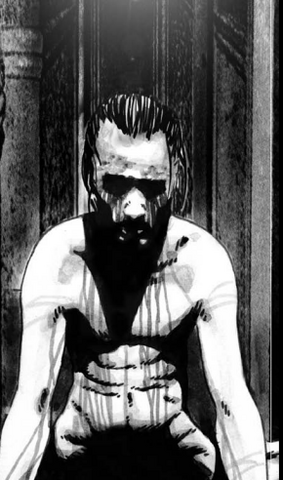
MKULTRA Survivor: This drawback indicates that you were one of the unfortunate people who didn't get any psychic powers from secret testing done on you, but still endured all the mental suffering involved. Every year you have to make a Simple difficulty Willpower roll to avoid gaining a new Drawback related to emotional trauma.
Psychic Burnout: In your backstory, you were either heavily traumatized by someone else, overdosed on MKULTRA psychic drugs, or were like Icarus and flew too close to the sun (the sun in this case being crazy mind juju). Whichever case, you have completely lost your psychic powers forever, and there's no way of getting them back. The upside of this is that your mind is extremely resilient against others' psychic powers.
Psychic Link: It turns out that there is something to all that "I can just feel it" talk about twins and lovers. You can use psychic powers on the individual you are linked to at any distance.
Psychic Sink: Also known as Psinks by Aegis agents in spite of how goofy that sounds, psychic sinks are individuals who aren't just unable to use psychic powers, but they actively drain its power. On top of getting all the benefits of Psychic Void, a character with Psychic Sink is able to reduce the effects of both psychic powers and the innate powers of Infused monsters around them.
Psychic Void: 99% of people have the potential for Basic ESP. Out of the rest, you have Psychics, Psinks, and these guys. A Void was just born without any psychic potential or extrasensory ability, and have both trouble with empathy and a hard time detecting supernatural powers being used around them. On the plus side, any ESP or psychic power used on a Void is weaker than it would normally be.
Supernatural Focus: This is a big drawback wherein you are basically a living conduit for the Seepage. Paranormal phenomena are more likely to happen around you because of this: spirits manifesting, ball lighting, raining fish, and more. This reminded me of the Weirdness Magnet disadvantage in GURPS, so I actually cracked open GURPS Conspiracy X out of curiosity, and sure enough that has Supernatural Focus be an advantage (odd choice, but okay) that requires Weirdness Magnet to buy.
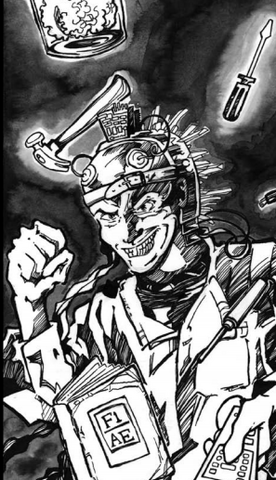
Pulling Strings
What Strings you can Pull is related to what type of Influence your bosses have and grant you through your Profession plus whatever Influences you buy with your own points, which can be in the category Civilian, Criminal, Intelligence, Law, Military, Paranormal, or Science and Research. For instance, almost all of the CAPS Professions have Influence (Paranormal), save for the CAPS Scientist/Parasychologist with Influence (Science and Research). Some even require specific allegiances, such as needing to be part of MOONDUST or the Ranch to get access to the Pulling Strings for requisitioning some extraterrestrial loot as part of your gear. Law Enforcement in particular seems like a really good type of Influence to have, as it can get you out of a lot of hot water. Just some of the Pulling Strings that Law Enforcement can get you include the ability to detain people, asset forfeiture, a good attorney or a judge who is in Aegis's pocket, police backup, being able to tell border control in your country to look the other way when you and your fellow agents are crossing a few national lines on Aegis business, and search warrants. Intelligence has a fair amount of really good ones too, such as blanket wiretapping.
Of course, just because those two Influences have a lot of toys to play with doesn't mean that they get the only good ones, of course. Science and Research can get you access to a secret CDC "panimmunity drug" that can cure any disease or mind control drugs to bend people to your will, for example. Civilian Influence is probably the weakest, with pretty much all of its Pulling Strings being news-related things like press passes and newspaper story manipulation, but even those could be used to good effect by a clever player.

Skills
Conspiracy X Second Edition posted:
The following list of skills is relatively extensive. As with all the rules in this book, however, it should always take a second seat to plain common sense. If a player is trying to twist the letter of the rules to wring some unreasonable advantage, the Chronicler should let common sense prevail. On the other hand, if a highly technical reading of a certain skill’s text prohibits what seems to be an acceptable use, the Chronicler’s discretion should also apply.
The list of skills here is sixty-seven strong, not counting subsets of a specific skill, and are sometimes a bit oddly categorized, to say the least. I don't have a huge problem with big skill lists most of the time
Conspiracy X Second Edition posted:
This skill covers all methods of healing not widely accepted by Western science, including herbal medicine, acupuncture, etc., each of which is considered a different Type. The effectiveness of each type of unconventional medicine is determined by the Chronicler. If the skill is effective in treating disease and injury, use the same skills and effects as the conventional Medicine skill.
Anyway, task resolution (the utilization of a skill) involves adding up your bonus to the skill, the Attribute associated with the task, a d10, and any modifier for how difficult the task at hand is. Did you get a 9 or higher? Congratulations, you passed! The actual difficulty track isn't until chapter 4, but for clarity on just what range you are aiming for, I'll note them early. You don't need to make any roll for a Routine task, get +5 to the roll for an Easy task, +3 or +4 for a Moderate task, +1 or +2 to an Average task, no modifier for a Challenging task, -1 or -2 for a Difficult task, -3 to -5 for Very Difficult, -6 to -9 for Heroic, and -10 or worse for Near-Impossible. What qualifies as any of these spots on the track is up to the GM, but the book suggests you should keep most things either Routine or Challenging to avoid bogging things down in minutia.
Next Time: Hideouts and handguns.
Ops Center
Original SA post
Chapter 3: Ops Center
Forming the Cell
In a rather involved bit of game mechanics, players are given the reigns to create the exact composition of the gear and base of operations for their particular Aegis cell. A cell's point buy system is what is referred to as Resource Points, or RP. Each player character contributes 5 RP per level of Influence they have, which goes to the five properties a cell has: Location, Facilities, Staff, Equipment, and Restricted Resources.
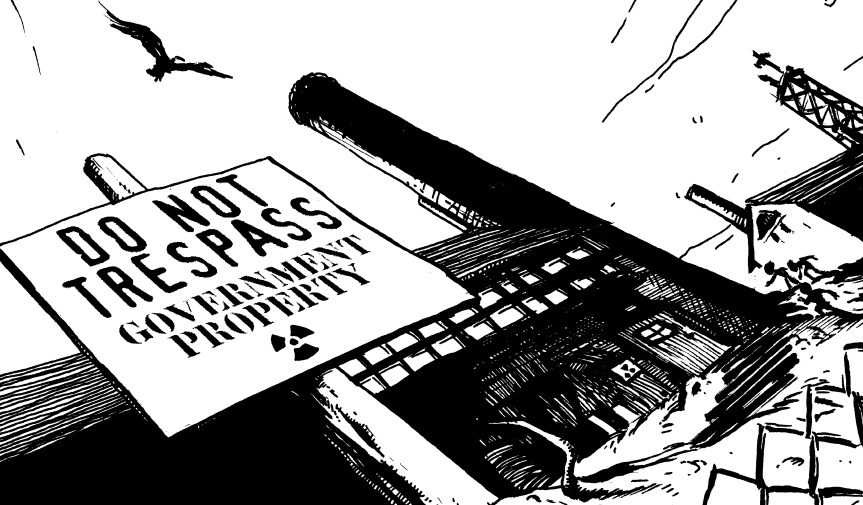
Location is, rather obviously, where your cell's base of operations is located. Each type of Location has a specific RP cost, number of free spaces to build things in, and specific restrictions on how things can be built therein (expect to see "cannot build an airstrip" and "no more than one four-space facility" most frequently). The very bottom of the ladder in both cost and space is a humble storefront, which costs a single Resource Point and has Space 4. These are supposed to only be used as either temporary ops centers or safehouses rather than main bases, however, so you probably won't actually get off that light on points. Just one more Resource Point nets you a Cold War bomb shelter with Space 5, and two more a private residence with Space 10, making these more reliable cheapo bases. Of course, they too suffer from being unable to build more than one Space 4 facility, lack any airstrip or helipad capability, and a private residence is both against official Aegis policy and removes your ability to have any facilities that would be visible from the outside, but that's the cost of cutting corners.
The rest of the Locations you can purchase all fall in line at five-point intervals. You've got industrial warehouses, large abandoned buildings(apartments, schools, etc.), private estates, office buildings at 5 RP, industrial parks and marine research vessels at 10 RP, and military bases, offshore oil rigs (for those of you who want to play Big Boss or the Enclave), underground bases, and underwater bases at 15 RP. The largest of all of these options are the estate and military base, both at Space 20. The estate requires someone wealthy enough to actually own an estate and tacks on the two most frequent restrictions yet again, while the military base only requires Influence (Military) and has no building restrictions.
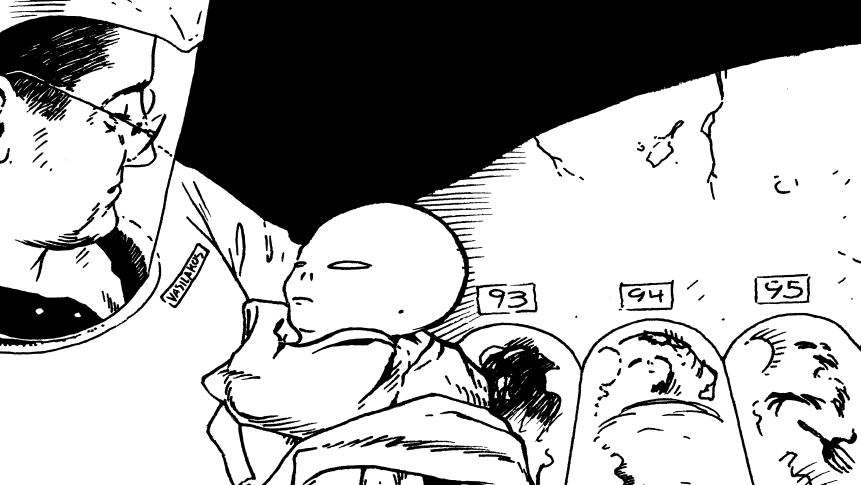
Facilities are all those rooms and such you stuff inside of your Location. They are mechanically quite similar to Locations, only they require Space rather than grant it. The facilities you can buy for your Location(s) are an airstrip, briefing room, ten-person barracks, biohazard containment area, brig/holding cell for up to four prisoners, telecommunications room, photography darkroom, dive bay, one-person dormitory, environment chamber (a room with full atmospheric, temperature, and humidity control), field hospital for up to five patients, firing range, two-vehicle garage, physical fitness gym, aircraft hangar, helipad, properly equipped hospital for up to twenty patients, one-patient ICU, life support generator for an environmentally sealed Location, computer mainframe, swimming pool, radar array, storage vault (a safelocked, air-sealed, radiation-proofed steel storage facility; regular storage rooms have no cost to the players), two-person suite, supercomputer, vehicle elevator (a must for underground vehicle storage), workspace (either a scientific laboratory, engineering workshop, or library), and desktop PC workstation.
A lot of Facilities with limited occupancy get linked together into a single Space 4 room if you try to get a certain number of them squeezed into one facility. For instance, two barracks, brigs, or suites together are a Space 4 facility, as are four garages.
Staff are basically NPC allies you pay RP to have on hand. They come in two varieties: Research Staff, which have a score of 2 in every physical Attribute and 3 in every mental Attribute combined with non-combat skills such as Computers or Occult Knowledge, and Operations Staff, which have the opposite Attribute spread and have a mix of combat and non-combat skills for helping out on a mission. Your hiring options are academics, computer specialists, doctors, engineers, lab assistants, scientists, and technicians for Research Staff and intelligence agents, drivers/pilots/sailors, and soldiers/mercenaries for Operations Staff.
All in all, cell creation is a really neat concept, as it gives the players almost-free reign in their base building dreams. I can also see the downside of potentially bogging things down in the minutae of allocating Resource Points into this and that and figuring out who wants what to be where, so it seems like the sort of thing that would be best planned out in advance before your play sessions actually gear up. It might have been nice to see a few sample premade bases as well, both for those who would like an example of working the system out and for groups who might want to just skip the base building altogether and live in a preset facility.
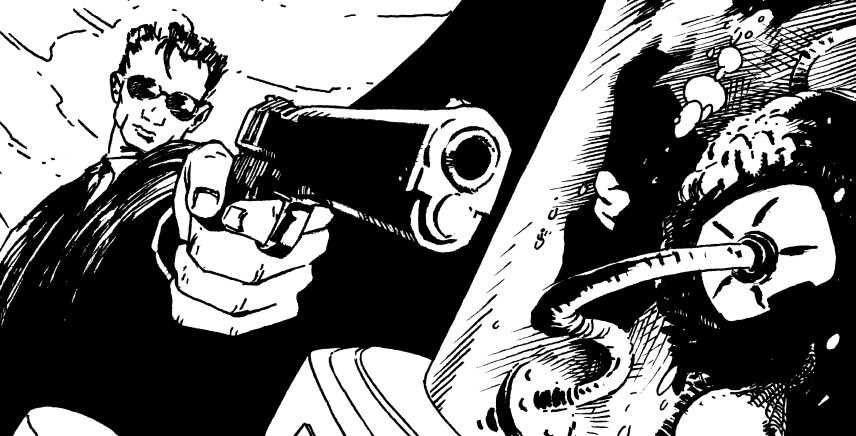
Weapons
And, of course, we have that thing that most roleplaying games have need for but is really hard to describe in any interesting sort of way: gear! All of your equipment in Conspiracy X can be bought with either Resource Points or cold hard cash, which makes sense given that your player characters are both singular entities and hands of a greater conspiracy and can draw on the benefits of both of those worlds when it comes time to kit up. Equipment also sometimes requires specific Influences to be purchased in the same way Pulling Strings and Locations/Facilities do, which again makes sense given the game's themes but might annoy that player who wants really wants a flamethrower but ends up realizing that nobody in the party has Influence (Military) to actually get one.
Weapons: The things you injure and kill people with are on the generalized level in Conspiracy X, foregoing the bits and bobs of Rugers versus Remingtons or what have you and instead going straight for [type of gun] does [level of damage] at [specific range]. On the melee weapons side, you've got a baton/large stick, club/small stick, large club/baseball bat/pipe/chair, small knife, large knife, hand stunner, huge knife/shortsword/ and staff, and then a ranged weapons table with thrown knife, thrown rock, dart pistol, dart rifle, derringer, ranged stunner (tasers and company), handguns in light, medium, heavy, and very heavy, submachine gun, civilian rifles in light, medium, and heavy, 12-gauge shotgun, assault rifle, sniper rifles in light or heavy, machine guns in light or heavy, and the good ol' minigun and flamethrower for overkill purposes.
One fun thing about weapons here is that you get a lot of them in bulk; 1 RP gets you twenty-four batons, for instance. What exactly are you gonna do with that many batons? I dunno, but you have them! Similarly, 1 RP gets you five submachine guns or handguns plus ammo, enough to outfit the whole gang (assuming your gang is made up of five people). Only the really big guns end up going at an equal 1 RP-one gun exchange rate (or 2 RP for one gun in the case of the minigun or heavy machine gun). Another fun thing, this time on a mechanical scale, is that there is an average damage listed for every weapon, for those who want to just go from attack roll to damage instead of attack roll to damage roll to damage.
Oh, and guns are capable of doing some pretty nasty things. I know this probably sounds obvious, but in some games gun damage isn't exactly stellar. In Conspiracy X, though, a .45 handgun, medium civilian rifle, light machine gun, or assault rifle slaps 1d8 x 4 damage in your face, and they aren't even the heftiest weapons you can have in your arsenal. As the game tells us earlier, the range of normal human Life Points is 18 to 58, meaning that a maximum damage shot from any of those weapons will tear through the majority of people, and even average damage will put a pretty good dent in you. Oh, and that's all before noting this fun fact:
Conspiracy X Second Edition posted:
A normal jacketed bullet tends to corkscrew and ricochet inside the human body, shattering bone, piercing vital organs, and doing assorted forms of mayhem. Thus, normal bullet damage is doubled after penetrating armor.
Explosives: For things that make a big spectacle, you have three separate damage levels depending on how close you are to where the explosive lies: Ground Zero (the epicenter), General Effect (the shockwave of effectiveness) and Maximum Range (the point where things start losing steam). Just how drastic these changes are varies. For instance, while C4 stays d6 throughout its explosive arc and only the multiplier changes, a rocket launcher's light rocket goes from d10 x 7 at Ground Zero to d6 x 5 at General Effect and d4 x 5 at Maximum Range. Explosives are categorized both by launch method and by type of explosive. For launch, you have straight-up throwing grenades around, hand-held or vehicle-mounted grenade launchers, light and medium missiles, and rocket launchers. The types of explosive that make up these categories are C4, Claymore mines, dynamite sticks, grenades in 40mm, AP, HEDP, defensive (smoke, stun, or tear gas), incendiary, and offensive (frag or flechette) varieties, missiles in light and medium, rockets, and satchel charges.
Ammunition: If you want, you can slap a +1 to Resource Point costs to get special ammo. It comes in the three flavors of armor-piercing (halve any Armor Value or Barrier Value of defenses in their way; AV and BV will be discussed in the next chapter, but for now you can basically sum them up in your head as being damage reduction), hollow-point (double AV and BV, but if you do inflicted damage it gets further tripled), and tracer (+1 to aiming rolls in a fully automatic burst).
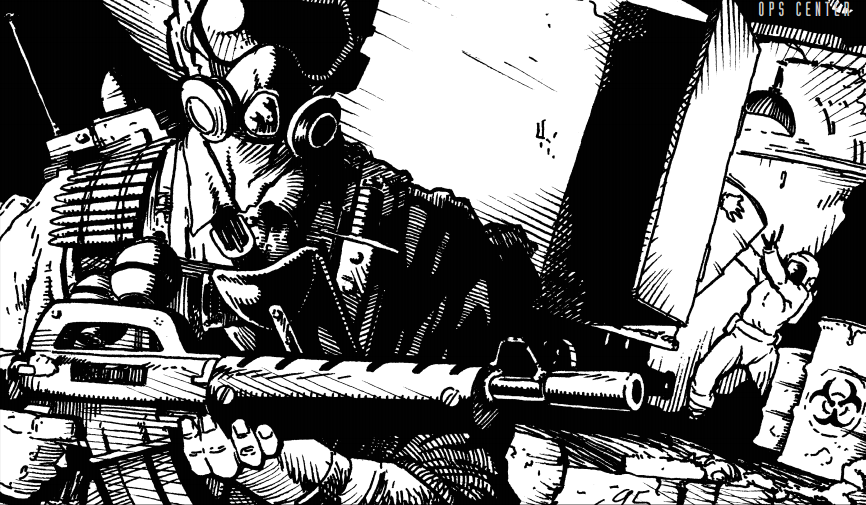
All the Other Sorts of Equipment
At the risk of sounding overly reductive, most of the rest of the material in this chapter is stuff that you probably wouldn't want to hear a lecture about, even if it's useful in-game. There's only so much you can say about lockpicks, wiretaps, night-vision goggles, and rifle scopes, especially since they are all either descriptive in nature or give minor skill roll bonuses. Such is the curse of the equipment section of a game. Of course, there is one section that covers the conspiratorial side of equipment with restricted gear. Almost all of them are marked with the statement that they are "strictly “need to know” and are discussed in Chapter Six: Classified (see p. 227)", but there are at least a few that get discussed here.
Magic Van: A special vehicle you can get for 10 RP if you have an NSA profession, the "magic van" gets its nickname due to the fact that it is capable of engaging in targeted electromagnetic attacks on individual pieces of computer infrastructure. These strikes, known as TEMPEST attacks, take 1d6 minutes and can strike any computer within a hundred-yard radius. While 80% of government infrastructure is TEMPEST-secured, civilian computers aren't so lucky and only have a 20% chance of having such shielding.
Special Weapons: Members of any CIA, DIA, CYGNET, or MKULTRA profession can reap the rewards of weird Cold War killing gear. These are more or less all regular firearms built into a mundane object, which disguises the weapon at the cost of a -1 combat roll penalty and quarter the normal ammo capacity. An example is given in the machine pistol briefcase (an SMG built into a briefcase), but otherwise it's up to the GM and players to figure out what these kinds of weapons are like.
SR-71 Blackbird: After the military decommissioned the SR-71, most of the stock that didn't get transferred to NASA went into the hands of Aegis, and players with a pilot profession can access these famously fast spy planes for their own use. The Blackbird is the only non-secret aircraft that is actually fast enough to take on extraterrestrial vessels in combat, and as a result Aegis SR-71s are often fitted up with salvos of heat-seeking missiles. Players are required to keep their SR-71s in a hanger whenever they aren't in use as part of secrecy and security protocols.
Next Time: Enter the Ruleschat zone.
Tradecraft
Original SA post
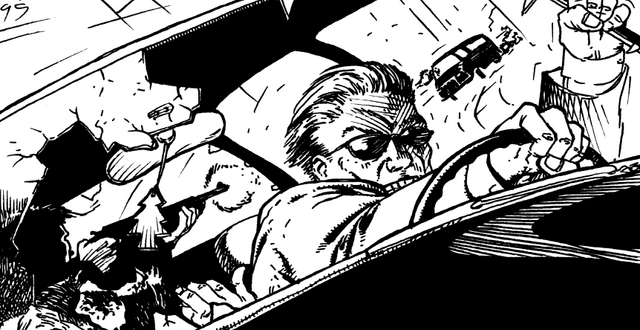
Chapter 4: Tradecraft
The Basic Rule
Ruleschat time. This is Unisystem, the system that is united. If you've read a Unisystem review before, you'll probably be disappointed at the lack of anything new to discuss here and may want to just skip this post. I'm going to try to balance covering things and not being too verbose on them as a result
Action resolution is entirely predicated on the d10 plus any bonuses and outside modifiers to the d10 roll. There are two forms of resolution that are present in Conspiracy X/Unisystem games. Tests come in two difficulties, with Simple being your d10 roll + (Attribute x 2), while Difficult is just straight up roll and Attribute. Tasks we covered the basics of back in the Skills section of chapter 2. If your Task or Test is meant be an opposed roll rather than targeting the usual result of a 9 or higher, such as a Simple Strength Test vs. Simple Strength Test for arm wrestling or Dexterity and Stealth Task vs. a Simple Perception Test to avoid being noticed, it is referred to as a Resisted Test or Task. If you don't have any ranks in the skill you want to use, you can choose to make a Difficult Test based on the Attribute associated with the skill's Task and an added -2 penalty. You also can't get an Outcome any higher than Decent when using an Task unskilled. What's an Outcome, you may ask? It's an optional degree of success related to the rolling of a Task or Test, which can be used "as often or as seldom as the Chronicler desires". So anything on this big ol' table...
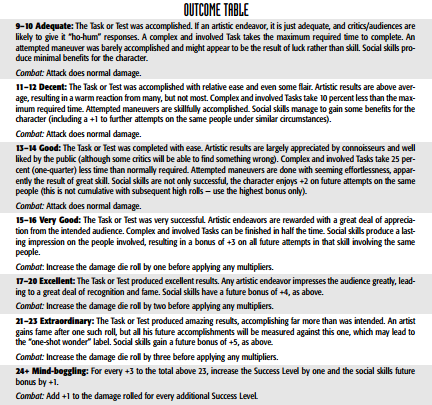
...can be ignored or utilized depending on whether or not you feel it's useful.
Finally, you have what is referred to as the Role of Luck. This is the Unisystem's name for its critical failure and critical success system. I'll just quote these because honestly it's a bit hard for me to attempt to put into simpler words.
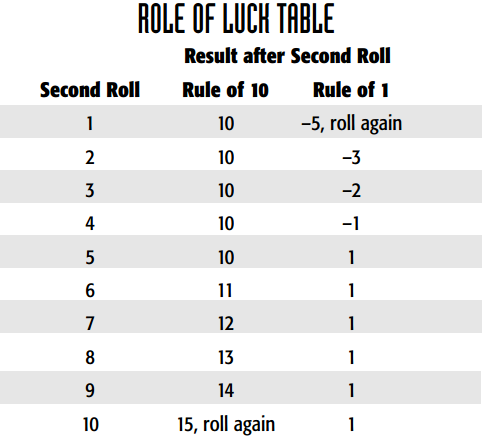
Conspiracy X Second Edition posted:
On a roll of 10, roll again, subtract five, and add the result (if higher than zero) to 10. If the second roll is five or less, nothing is added and the final roll remains 10. If another 10 is rolled, add five to the roll (for a total of 15), and roll again. If a player rolls a string of 10s, he keeps adding fives to the result and rolling again. The possible results are summarized in the Role of Luck Table.
[...]
On a roll of one, roll again, subtract five, and if the result is negative, that negative replaces the first roll. If the result is positive, the roll remains one. If the second roll is one, the prior roll is replaced with –5, and the player must roll again (applying the same rule). The possible results are summarized in the Role of Luck Table.
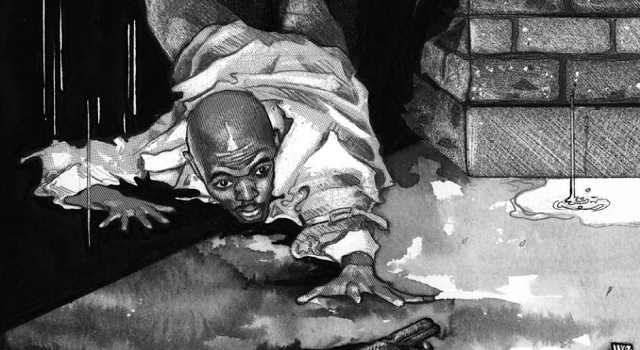
Getting Scared
Fear Tests are your standard fright checks. These are a Simple Willpower Test in most occasions, changing to a Difficult Will Test if a character has psychological complications that weak their resolve in the situation. Some events can add a negative modifier to the roll, with the same light hand being given here as it has been in other situations describing modifiers: "very gory and gruesome events", "hideous creatures", and "alien or thoroughly evil auras that inspire a deep, instinctual fear in people" each have their own range of roll penalties. There are also optional rules for forcing Fear Tests if you are shot, or even shot at if you are particularly cruel.
You can choose to either be simple and have most failed Fear Tests just result in either a lost turn or a desire to run away (which always apply for the above shot/shot at optional rules), or you can consult the dreaded
 Fear Table
Fear Table  , wherein lie such effects as d8 turns of screeching and babbling, shitting yourself, fainting, gaining new Mental Drawbacks, or having a heart attack. What is always set in stone is that you lose points of Essence due to failing a Fear Test. This is a single Essence point for a roll of 7 or 8, 2 Essence for a roll of 5 or 6, d4 on a 4, d6 on a 3, d8 on a 2, and d10 on a 1.
, wherein lie such effects as d8 turns of screeching and babbling, shitting yourself, fainting, gaining new Mental Drawbacks, or having a heart attack. What is always set in stone is that you lose points of Essence due to failing a Fear Test. This is a single Essence point for a roll of 7 or 8, 2 Essence for a roll of 5 or 6, d4 on a 4, d6 on a 3, d8 on a 2, and d10 on a 1.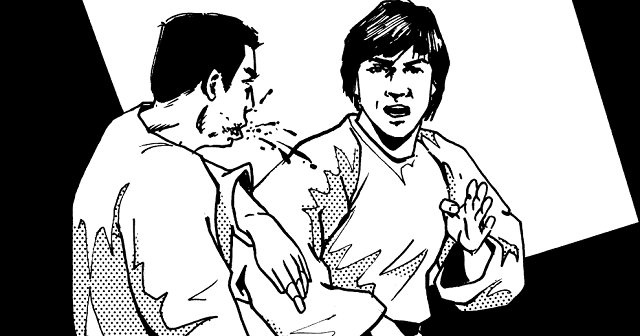
Combat
Hurting each other is a specific type of Task that is a bit more involved than most, and has a specific turn order in order to keep everything clean. Each turn of combat is broken down into Intention, Initiative, Performance, Damage, Repeat (have the previously four steps repeat for each other player in the turn), and End Turn. After everyone declares their Intention (what they want to do in the turn), you roll for Initiative via d10 + Dexterity and determine who moves first, second, and so on and so forth. You can also just eschew rolling entirely and decide who goes in what order by what action they are taking, if that suits your fancy.
Performance is the actual Task rolling. Close combat (two individuals with unarmed or melee weapons) allows for one combat Task and one defense Task or Test, with any actions beyond that having a cumulative -2 to their roll, while any other form of combat starts piling on those -2s for any action past one initial one. Hitting someone is a Task that has Dexterity plus the relevant weapon skill for its roll, while dodging is either Dodge + Dexterity for those who have that skill or a Difficult Dexterity Test for those that don't, and the two are obviously Resisted Tasks/Tests against each other if both sides are engaging in action and reaction accordingly.
Martial arts in particular are a bit more complicated, in that the Martial Arts skill has its own set of techniques, known as Combat Moves. You get to choose three Combat Moves that are always the same level as your Martial Arts skill, as well as a special pool of points based on your Martial Arts level that you can use to buy up further Combat Moves. You get 3 Combat Move points per level of your Martial Arts skill, with Combat Moves outside of your free core three costing 6 Combat Move points for their first level and then a single point for each additional level. You can't raise a Combat Move's level higher than your Martial Arts skill's level.
Most Combat Moves are the same as those in All Flesh Must be Eaten's martial arts book Enter the Zombie, including techniques such as Choke (win a Strength and Choke Task vs. a Strength and Constitution Test on a grappled target to choke them for -2 to all their actions and a lack of air), Disarm (win a Dexterity and Disarm Task vs. Dexterity and weapon skill Task to disarm someone), and Roundhouse (deal d6 x Strength damage, but you can't make any other attack actions in your turn). A big change, however, is that you can now buy Combat Moves grouped together as Combos. Combos cost a number of points equal to how many Combat Moves as in the Combo, though you can attempt them unbought at a -1 penalty to your skill rolls. They're a pretty risk and reward type of maneuver to pull off: get all the skill rolls for each Combat Move pulled off and you have a flowing set of actions that don't suffer the normal penalties for multiple turn actions, screw it up (be it a failed roll, a dodged attack, or a blocked attack) and you both have your combo end and your turn's move actions spent up.
What can make Combos even crazier is the three new Gun Fu Combat Moves added in Conspiracy X. As you might guess, Gun Fu moves are Combat Moves that put a pistol into your melee maneuvering. The Draw Pistol move is vital in combos, as it is what allows you to segue from fist to gun, and is needed to prepare for the other two Gun Fu moves, Pistol Whip (smack a guy with a pistol, deal d4 x [Strength + 1] damage) and Shoot (you shove the shooty end of the gun into your opponent, dealing the gun's damage at melee distance for great effect, but at the cost of the foe being able to knock the gun away with a Martial Arts move before you blast them).
Ranged combat unsurprisingly adds range into the mix. The generic no-issue range is labeled "Short Range", with any range lower getting bonuses to hit and/or higher damage multipliers and any range higher going the other way.. There are also some guns that treat multiple action penalties differently, with non-heavy recoil semiautomatics having a cumulative -1 rather than -2 and automatics having special fire options. An automatic weapon gets to fire a volley (three to five shots for a burst fire, and ten for hosing/"rock 'n roll") that count as a single attack roll and action at the cost of a greater penalty for multiple actions in the turn. Such automatic firearm attacks look to the Outcome roll table, with each level of success up to the number of shots fired equaling another damage roll that removes the usual multipliers and just deals a flat die of damage instead.
And if all of this is a bit too much for you, you can choose to utilize the Reduced Rolls system. It has you create flat scores for enemies rather than roll for them, putting all the rolls in the hands of the player. An enemy's attack "roll" is always Dexterity + weapon skill + 6, their defense is always the same formula but with Dodge instead of a weapon skill, they always deal the average damage of the weapon they use, and their armor is similarly always averaged.
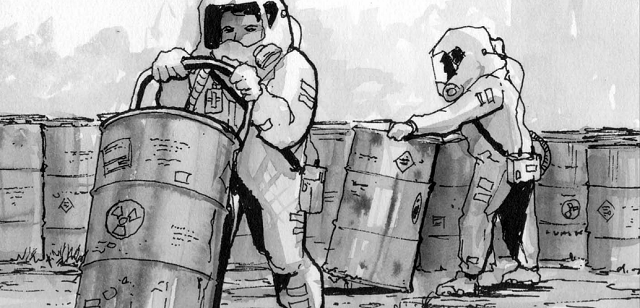
Damage and Injury
Sheer physical damage is all about the multipliers in Conspiracy X due to the lack of multiple dice for weapon damage, as was went over during the discussion of weapons last chapter. One of the ways to boost this damage is through called shots (or Targeting Body Parts, as it's called here). This is the kind of knowledge that will make your enemies get all worried and yell out "watch out, they know about
Weapons aren't the only way things can hurt you, of course. You could be struck by poison, for instance. Conspiracy X breaks up poisons into three types: Corrosive and Irritant deal Life Point damage in a single die roll or over time with each dose respectively, while Narcotic is any type of poison that can induce drowsiness, unconsciousness, or organ failure. There are also a number of other effects such as disease, radiation, and drowning that pit the character in a Simple Constitution Test against a Simple "Strength" Test, with the Strength score being based on the potency of the danger in question. And, of course, there's also straight up damage rolls for falls and fire.
On the opposing end of the paradigm to damage is defense. Armor is of the damage resistance/reduction variety, wherein the armor has a flat number plus a roll of a die. This number is how much damage from an attack ends up getting removed from an incoming attack, with full removal meaning the attack was fully absorbed. The available armors back in the last chapter are a generic body armor ("worn by SWAT teams and military units"), bomb suit, diving suit, generic hard helmet, radiation suit, kevlar vest, light vest (meant to deter melee weapons, not bullets), and wetsuit. The wetsuit is weakest with d6 +1 protection, while the bomb suit is the heftiest with d10 x 5 + 20. Static objects have both their own Armor Value and an equivalent for people hiding behind them, known as a Barrier Value.
Once you've taken damage, you have to deal with the injury. 5 to 2 LP causes a -1 to most rolls, 1 LP means you are suffering -5 to those rolls. Once you hit 0 or below, you're making a special Willpower + Constitution - (HP below 0) Test known as a Consciousness Test to stay lucid and act for that turn. Hitting -10 means you are very much in trouble and are forced to make a Willpower + Constitution - (HP below -10) Test known as a Survival Test then and there, plus every minute afterward, accumulating a further -1 to the roll for each minute that passes. If you fail, you're dead. Someone who's dying can be stabilized by medical attention and certain psychic powers, and if you get to them in time you can even resuscitate a recently dead individual. Assuming they're not, like, decapitated or atomized or something, of course. LP recovery is either natural or aided through the First Aid skill.
Attacks meant to KO someone and strenuous activity drains Endurance Points instead of Life Points. Getting to 0 Endurance Points means you are making a Consciousness Test at a -1 penalty for every 5 Endurance Points below 0 you have reached, with failure meaning you fall unconscious. Finally, Essence Point loss is its own strange beast. Reaching 0 Essence causes you to become really depressed, causing a -3 penalty to all Tasks and forcing a Difficult Willpower Test to avoid either losing a point of one mental Attribute or temporarily gain some mental illness on the Drawback chart. Go all the way down to -30 and you are forced to make a Survival Test to avoid dying via your soul just giving up, leaving no obvious cause of death and contributing to a fair number of "heart failure" diagnoses on the books.
Experience
EXP! You know it, you love it, it's all right here at the end of each game session. Experience points are point buy points just like those at character creation, only you have to both explain how you got better at what you got better at and need to spend more points for certain things than you would have at character creation. For instance, you can only raise an Attribute score by a level above the level it was at character creation, which costs 5 EXP rather than the 1 CP it costs to add a level of an Attribute back during chargen. On top of Experience Points, characters get to choose what they do for "downtime" between sessions, recommended to be around two weeks of in-game time wherein the agents can train, gain more resources, get therapy, and extended their sphere of influence.
Next Time: With all that cruft over, it's time to look at ghosties, ghoulies, and terrible beasties. Chapter 5: The Paranormal looms ahead!
The Paranormal
Original SA post
Chapter 5: The Paranormal
The first of the two "GM's Eyes Only" chapters at the end of the core rulebook, chapter 5 gives an introductory look at the world of the supernatural in Conspiracy X, with a brief statement at the start that those who want deeper insight should go look at The Paranormal Sourcebook (which would be six years away at the time of its original printing, but oh well, details!). This is where all the stuff about psychic powers, magic rituals, and anything else Fortean that isn't directly technology- or extraterrestrial-based goes.
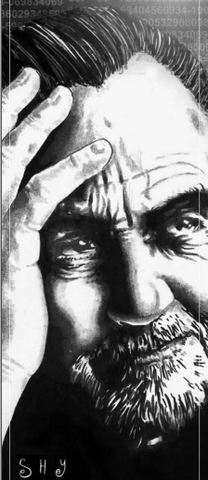
Psychic Abilities
Psychic abilities, or psi, are a manifestation of the human consciousness wherein the mind can sense and affect reality. In spite of how much research has gone into psi through the parasychologists of MKULTRA, Project Rasputin, and Aegis, it is still unknown just how the process works on a hard science level. Research suggests that nearly 95 to 99 percent of humans can utilize psychic powers, which is an insanely high number when you think about how big the population of Earth is. Of course, as noted back in chapter 2, the overwhelming majority of individuals merely have the Basic ESP quality, rather than being what are known as proper psychics. These sorts of psychic manifestations are what lead to "gut feelings" and the like that all non-damaged ("damaged" in this case being someone who is either a Psychic Burnout, Psink, or Void) humans have, divided into five specific powers in the Basic ESP quality. Characters can only use a specific one of these five powers once per week, and success requires either a Difficult Willpower Test. All five of them let you get an answer to a simple yes-or-no question about one thing in particular: Hunch for present events, Intuition for someone's intended thoughts about their course of action for the next hour, Ken for past events, Read Aura for someone's emotional state and vital signs, and Second Sight for future events.
Full-fledged psychics have access to greater powers, which they can buy with character points. Each psychic power has two stats to it for a character: Strength is how much raw oomph you can put into the power, while Art is basically just the skill level equivalent. This means that, depending on how you wish to allocate your points, you could have someone who has a bit of a hard time landing their psychic power but can break reality over their knee when they do, someone with very little punch to their powers but an almost unerring ability to activate them, or something in between. While most of the fun powers like mind control and pyrokinesis are over in The Paranormal Sourcebook, three psychic powers are provided in the Conspiracy X Second Edition core rulebook itself.
The first power, Clairyovance, is like like Hunch on steroids; indeed, once you have any points put into Clairvoyance, any uses of Hunch that the GM accepts are automatically successful without need for a roll. Clairvoyants can see place, people, and events from afar, as well as look inside locked objects, or even act as an early warning system by psychically detecting nearby threats. You go from having brief flashes of events happening a few yards away to detailed long-term visions several miles away as you head up its Strength track.
Telekinesis, also known as psychokinesis, is primarily made up of moving and throwing objects remotely. You can also use it to buff your physical strength and melee attacks, land ranged invisible punches, parry attacks other than bullets, and create force fields. The Strength of your Telekinesis gains further lifting capacity and damage capabilities at the same rate as the Strength attribute.
Finally, there's Telepathy. You know the drill: you can talk to people through their mind, and they can talk back. It can also block others' attempts to poke into the psychic's own mind, and at Strength 4 or more you can burn a point of Essence to "psychic scream" inside someone's mind and briefly overload their senses. Like Clairvoyance, the range of Telekinesis is boosted with greater Strength, starting out needing to actually touch someone to access their thoughts and ending with dozens of miles of reception.
It's worth noting here that there's a sidebar in this section on eschewing normal rolls for Basic ESP and psychic powers, instead using a Rhine Test. This is a reference to an actual set of experiments regarding ESP conducted by parapsychologist J.B. Rhine and psychologist Karl Zener in the 1930s utilizing "Zener cards", a deck of cards depicting either a circle, a cross, waves, a square, or a five-pointed star. With this optional rule, rather than making any normal die rolls, you print out a set of Zener cards provided by the book and ask the player to guess the correct symbol of a card they are about to draw in order to use their character's psychic power. Weird? Perhaps, but it's certainly interesting as well.
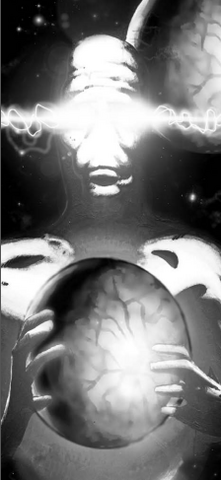
Seepage
While Aegis was created to combat the extraterrestrial menace, its ancestor was a conspiracy known as the Watch, which investigated and fought against the strange occult things of this world. While those concerns may have taken a back seat to aliens, they are nonetheless ever-present, and knowledge is power. One of the biggest sources of knowledge Aegis has gained was the 400 page occult manuscript known as the Queens Tome, written sometime during the 1950s and uncovered in Queens, New York, in 1983. It spoke of various visions of madness and chaos, but most importantly it laid out an understanding of what is now known as Seepage. Seepage is the psychic runoff of the entire human species, bound to the planet as a great "world-mind", a sort of collective unconscious. Seepage is constantly fed by the dissipating energies of the human aura and its favored meal of the psychic trauma let out by fear and anxiety. The more stressed and afraid people are, the more heartily Seepage gets fed, and the more powerful it gets. When enough energy comes into a single area over a duration of time, Seepage is capable of acting as a sentient and malevolent force, using the superstitions and fears of the people in the area to build manifestations of their beliefs to keep the cycle of fear energy flowing.
Ambient Seepage first gathers in one place as a Pool. Temples and churches, haunted houses, crime scenes, battlefields, and other areas with strong emotional impact are where Pools crop up and the aforementioned sentient part of Seepage awakens. Feed it enough psychic energy that it becomes extremely famous the world over and the Pool evolves further into a Locus (as in genius locus, the Grecian "spirit of place"). The Bermuda Triangle? That's a Locus. Stonehenge? Yep. The Pyramids of Giza, Tenochtitlan, Easter Island, Vatican City, and Jerusalem are also well-known Loci.
The main mechanical effect of the strength of Seepage is the Seepage Points system. SP is what fuels both guided magic and the random Fortean phenomena that pop from Seepage from time to time. ambient Seepage or an undisturbed Pool has 1 to 10 SP, an "agitated" (strengthened by recent traumatic events or heavy ritual use) Pool or average Locus has 5 to 50, and an agitated Locus has 30 to 100. This gets boosted during certain events: +5 at noon or midnight, +5 during the day before, during, or after a full moon, +20 during a solstice or equinox, and +30 during the Gaelic sacred days of Imbolc, Beltane, Lughnasadh, and Samhain. Furthermore, each Supernatural Focus on the scene boosts the SP by twice their Willpower, while each Psink present reduces it by that same amount. Lost SP is regained each midnight.
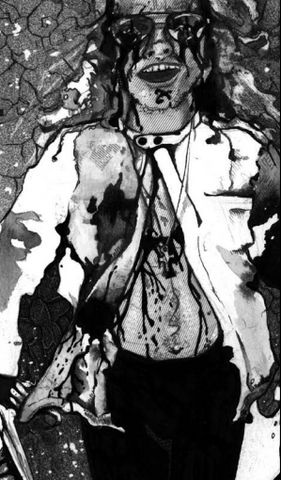
Rituals
Magic in the world of Conspiracy X is effectively codified Seepage manipulation. Long, complicated rituals are utilized to draw its power out and shape it as the ritualist wishes. All rituals are effectively their own skill, being bought up and mostly rolled as any other skill would be, and you can even cast one as an Unskilled Task if you have the instructions of the ritual handy and are either really desperate or really stupid. There are a few differences between Ritual Tasks and other skill rolls, however. First off, you've got to have enough SP to actually cast the ritual in the first place, otherwise the Ritual Task just fails then and there. You can get d4 free SP for each level of success on the Outcome chart you manage with your Ritual Task, but it's not really a reliable enough source of extra juice to lean on it too heavily. Second, having enough Seepage to fuel the ritual but still fucking up your roll means you have to make a Difficult Willpower Test to avoid gaining a stage of Corruption. And, if you recall, Corruption is very much a not-good thing.
Five rituals are presented in Conspiracy X Second Edition, with a small paragraph giving some basic rules for gauging the strength of your own homebrew rituals and even more rituals being found in The Paranormal Sourcebook. Three of these rituals are all related to spirits, a type of manifested being of Seepage: Banish Spirit lets you take d4 hours to disperse a spirit back into its primal energy, Bind Spirit is a half-hour ritual to bind a minor spirit to your will for a whole day (this gets an optional free banishing by commanding the spirit to depart), and Summon Spirit is a three hour ritual to call forth a new spirit or reform a banished one.
The Ritual to Cure Corruption is a two hour ritual to purify someone of the Corruption that has taken hold of their body. It is an especially risky ritual, as success or failure deals d6 x 2 Life Points from strain, the subject failing a Simple Willpower Test after the spell has been successfully cast can render them a Void or a Psink, and a failure of the spell after SP has been gathered means both the normal risk of Corruption for the caster and an immediate Test to see if the target snaps then and there. Talk about your risk and reward solutions.
Finally, a Warding Circle is the quickest ritual at only five minutes to complete, and lets you forge a magic circle or square that keeps spirits and Infused from crossing it, be they inside or outside of its radius. A Warding Circle lasts for up to a day, though any breakage of the physical markings that denote its limits will immediately end the effects. While the entity cannot break the circle on its own, it can attempt to influence those who can.
Manifestations
These are random supernatural events caused by Seepage. Some types of manifestations include cold spots, disembodied voices or other strange sounds, sudden feelings of melancholy, shadowy figures or phantasmal images, crop circles, ball lightning, ectoplasm, and spontaneous psychic power usage. There's only a few vague paragraphs on the subject here, with a far more in-depth look at paranormal phenomena associated with Seepage manifestations in...well, you can probably guess by now.
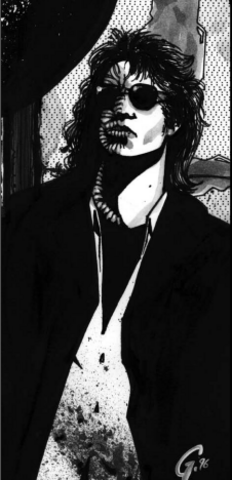
Corruption
As one slides into embrace of Seepage, they become corrupted by dark influence. There are six stages of Corruption, each granting a drawback or (more rarely) quality related to the path the individual is being taken down. This, like many things in this chapter, is kept on a strict "GM should do it" level, with actual hard-coded "you get this drawback at this stage for this archetype" rules being in you-know-where. Corruption mainly occurs from failed rituals, but spirit possessions, intentionally corrupting rituals, and various other "rarely subtle" Bad Things of the Seepage. Every time the corrupted individual gains another stage of Corruption, they have to make a Simple Willpower Test penalized by how many stages of corruption they have reached, failure meaning that they snap. After snapping, they have to make a Difficult Willpower Test, with failure meaning they become the Forsaken and success making them Infused. Supernatural Foci always become Infused if they snap. Snapping replaces the Forsaken or Infused's Essence stat with their own personal Seepage Pool of the same amount, which they can use alongside the ambient Seepage around them to fuel Infused powers (things like supernatural regeneration, the creation of mind-slaved thralls, and illusions) or rituals.
One thing that is made abundantly clear by the text is that corruption doesn't form species or anything of the like. Instead, each corruption always spread the same Archetype. Archetypes can be any sort of cultural standard, from Carl Jung's archetypes and concept of personas to religious figures to symbols of the Tarot. Being bitten by a vampire, for instance, doesn't necessarily mean you are going to become a vampire: a vampire is an avatar of the Predator, but so are werewolves, wendigos, and slasher movie villains, and its corruption could manifest along any of those paths. Forsaken are unfortunate enough to know that they are supposed to fit their Archetype but have no physical changes or Infused powers to back up what their brains are telling them, so they are complete and total messes. Of course, in spite of actually getting the whole body transformation part of the deal, the Infused don't fare much better. Conspiracy X takes a "the mind is the plaything of the body" approach to metamorphosis, and even Infused that snap early enough that they only get one or two drawbacks will almost always eventually succumb to fitting into the monster-shaped box they have been put in.
Spirits
Spirits are the after-images of the dead; the actual person's soul, if souls even exist, and consciousness most certainly aren't present. Most spirits are either weak snapshots that repeat the same traumatic experience that led to their death over and over again or barely sapient and incapable of forming long-term memories. There are more powerful sorts, such as demons (Infused spirits that have created the legends of things such as angels, devils, and dragons) or ascended ghosts (particularly powerful possessing spirits), but we won't meet them until The Paranormal Sourcebook. For the meantime, we have regular old ghosts, which effectively have the same stats as a normal human save for the ability to do anything physical rather than mental, which has been traded for access to Infused powers and Seepage manifestations. For unknown reasons, almost all spirits dissipate within a few decades to a few centuries, with truly ancient ghosts being extremely few and far between.
Next Time: We enter the final chapter, wherein the deepest secrets that aren't in some other sourcebook are revealed. Meet the three extraterrestrial species, learn the Mostly True History of America, and more in Chapter 6: Classified.
Classified
Original SA post
Chapter 6: Classified
Welcome to the final chapter of Conspiracy X Second Edition. Here, all truths will be revealed! Except for the ones that are revealed in supplements of course.
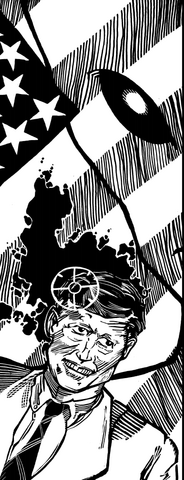
Recent History
This is a history of the paranormal as handed down from Aegis Prime, tainted and subjective as it may be as a result. This is to enhance the whole conspiratorial "do you think you really know the truth" aspect, allow for contradictions in future sourcebooks, and (most importantly) as an easy explanation for the GM to easily change whatever parts of the setting they don't like with a simple "that's not how it REALLY happened".
The story starts in the 1930s with a Venetian occultist named Walter Stein. Stein studied the mysteries of the arcane in Germany in the 1920s, being a fellow student of a guy by the name of Adolf Hitler. Around the same time Stein became an initiate of the Secret Doctrine, a cabal of the most powerful mages in the world, Hitler was tapping into the darkest parts of the Seepage in between his political machinations that would form the Nazis. Stein understandably had an "oh shit oh shit oh shit" moment upon discovering his former compatriot's actions and quickly fled from Germany to England. Once there, he warned Winston Churchill of the coming storm, who in turn passed it on to FDR, and all three grouped together resources to form an anti-Nazi society of soldiers and spellcasters called the Watch. It was the Watch stalling the Nazi occultists' plots, including via several assassinations and successfully stealing the Spear of Destiny, that allowed World War II to go on without direct supernatural intervention.
With the Nazis defeated, the Watch became primarily a research organization, focusing both on existing paranormal phenomena and the strange reports of "Foo Fighters" that came in from both sides of the war. The wait for more information wouldn't take long at all, as Watch psychics managed to accidentally contact extraterrestrial beings flying in Earth's airspace on March 17, 1947. The significance of the event is not lost on the Watch even though just what these strangers from outer space were psychically chatting about wasn't clear. Things escalate even further when a UFO starts repeatedly flying over White Sands Proving Ground in strange and erratic patterns a few months later.
The Watch quickly tears itself apart over what to do: those who wish to make first contact form a coalition called Operation Dove, while those who have the much simpler solution of "shoot that fucker out of the sky" call themselves Operation Pigeon Shoot. And shoot that fucker out of the sky Operation Pigeon Shoot does, slamming a hastily compiled high explosive yield V2 rocket and forcing it to careen through the sky and eventually crash land in Roswell, New Mexico. Unfortunately, Operation Dove members were trying to make first contact at the same time, and the psychic backlash of the pilots' being mentally contacted as they died in a horrible explosion managed to do some real damage. Of the Operation Dove team of nine, one spontaneously combusted, two died of simultaneous aneurysms and heart attacks, one was left permanently comatose, three became clinically psychotic, and only two managed to walk away unscathed. Neither group actually gets the booty, either, as a covert third group of Watch members that are ashamed of their comrades' betrayal of each other abscond with the wreckage and corpses that was packed up and shipped to Fort Worth, Texas, by Operation Pigeon Shoot. What little remained on site in Roswell was taken by Project Dove at the same time they created a smokescreen by replacing said material with a broken weather balloon.
Surprisingly, in spite of each group's initial purview, it is actually Operation Dove that ended up forming what is now Aegis, the realization that first contact never would have worked dawning on them with more and more dark actions of the extraterrestrials. Operation Pigeon Shoot's initial goal of defending humanity through force was replaced with the grinding demands for more and more results by the military industrial complex forcing them into eventual agreements with the Grays and Saurians in order to easily attain their technolog and transforming them into the NDD/Blackbook. While Blackbook stayed in the past with heavy ties to the Army and Navy, Aegis managed to gets its hooks into the newly created Air Force and CIA, resulting in projects such as MKULTRA and MOONDUST discussed back in chapter 2. There were also disturbing rumors in both organizations about an uncatchable group called the Majestic 12 whose goals and methods seemed to align heavily with the original Watch.
By the 1960s, most of the government and even some private sector groups had Aegis cells implanted, the Ranch had been built at Nellis AFB to conceal the society's deepest secrets, and the HERMES network was up and operational. Then things went south in 1963, with JFK learning that Aegis had been monitoring his every move via infiltration of the Secret Service. The cell got the call from Aegis Prime to make no attempts at brokering a deal with Kennedy, and to instead end him during his visit to Dallas. They called up MKULTRA psychic Lee Harvey Oswald to be the gunman, with two other precogs stationed to use telekinesis on the bullet to make sure that the bullet would do as much damage as possible. There was also a second shooter on the grassy knoll, affiliated with neither Aegis nor Blackbook and once again unable to be sniffed out and discovered after the incident, leading to increased paranoia from Aegis Prime.
Things only got more complicated in the 80s and 90s, with Saurians sabotaging the rocket boosters of the NASA shuttle Challenger with aid of Blackbook informants, ecologically-minded Saurian infiltrators helping fuel the rise in sentiment pointing the finger at industrialization as the cause of global warming, Blackbook puppeteering the Gulf War, and rising public paranoia over Y2K. Heading into the new millennium proper, human fears were at such a peak that the Seepage began churning out supernatural phenomena and Infused at the highest rate since the dawn of the 11th Century. This wasn't helped by 9/11, one of the few events explicitly called out at being entirely human-caused and not influenced by aliens or magic (though Ground Zero is now an extremely powerful Locus, to the point that the towers can still be seen standing if you look via aura vision). Human attempts to reach the stars without extraterrestrial aid were ground to a halt with Saurian sabotage of space shuttle Columbia and carefully planned misdirection of probes on Mars. The War on Terror was a horrible thing, and may or may not have been the results of George W. Bush being a Saurian wanting to weed out a renegade tribe of Saurians living in Iraq.
All of that brings us to the "present" of 2006, with status quo updates on both Aegis and Blackbook. For Aegis, the big goal is ending any threat of extraterrestrial origin, be it through some peaceful resolution yet to be found or through some future XCOM-esque technowar. Seepage is seen as a trivial matter that is to be used as a tool and investigated rather than fought against. Blackbook, meanwhile, continues to blindly march forward in its quest for technology. The group is so interconnected with the Saurian species at this point that Saurians modified to look like humans, known as Men in Black, are frequently Blackbook agents themselves. They also get free psychic goodies from the Grays in exchange for looking the other way as they abduct and experiment on the general populace.
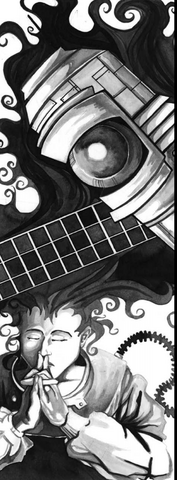
Aegis Special Resources
This section's where all of the special toys Aegis has access to finally get laid bare.
Alien Technology
This is, as its name implies, stuff gained from the aliens by either pilalging their wrecked ships or taking it off their cold, dead corpses. Taken from the Grays are psychic lenses (special augmentation orbs that boost the power of one's psychic powers), from the Atlanteans come particle accelerator rifles (a high power particle beam that deals a terrifying d8x10 damage; these are normally powered by special bio-batteries connected to the Atlantean's body, but human versions get MacGuyvered up with car batteries or other electrical power sources), and from the Saurians are field generators (harnesses that create a deflector shield around the wearer or make contra-gravity fields to levitate them, both of said functions being exclusive to each other) and plasma claws (large clawed gloves that can create and shoots plasma balls).
Atlantean Nanotech
Mentioned separately from other alien technology are the nanomachines utilized by the Atlanteans. These can be implanted in humans, but don't work as effectively a they do in Atlanteans (read: they can do horrible things to you if you are a human), and are also susceptible to being destroyed by EMP bursts or other high concentrations of electromagnetic radiation. The individual systems are as follows.
- Aspect Modification System: A special minor shapeshifting device, allowing the nanites to reform the flesh. d6 damage to yourself and a Simple Willpower Test lets you change your skin color, skin abnormalities (blemishes, scars, and tattoos), eye color, and hair length, style, and color in a few seconds, d6x2 damage and a Simple Willpower Test -3 lets you reform your facial features in a few minutes, and d10x2 damage and a Difficult Willpower test allows you to adjust your height by six inches shorter or taller over an hour of excruciating pain. For Atlanteans, of course, there's no pain, no damage, and no Willpower Tests needed.
- Bio-Battery Energy System: This handy set of two nanite-laced batteries inserted into your palms converts waste material into energy, meaning you never have to go to the bathroom in your life again. It also conveniently allows you to power Atlantean devices that run on bio-batteries as well as do a once per hour mass discharge that can fry any non-shielded piece of electronics or stun a person for d10x2 turns. Unfortunately, since it was made for Atlantean physiology, the system "runs hot" in humans, making you always have a low grade fever.
- Blood Surgeon Repair System: These medical nanites sit around in the blood stream, waiting for any warning sirens about something horrible happening. They half the time needed to heal damage, as well as instantly stabilize the user without a Survival Test. Of course, in humans, they can malfunction, so you end up having to roll a d10 any time you suffer lethal damage; if the result's a 1, instead of stabilizing you the nanites flip out and start trying to repair Atlantean biological parts that aren't there, dealing a further d6x2 damage.
- Pilot Interface Control System: On top of being the only way to pilot an Atlantean spacecraft, these PICS allows a boost of reflexes that grants +1 Dexterity and +10 Speed. While Atlanteans can automatically perform this boost, humans need to make a Simple Willpower test to keep it active for d6x2 turns. It also has the "roll a d10, fear a 1" thing, with a roll of 1 causing the boost to overload and the user to suffer from a seizure for d10x2 turns.
Aurora III
The latest in a line of super-fast stealth aircraft designed for Aegis at the Ranch, the Aurora III is a triangular craft made with systems cannibalized from crashed Atlantean and Gray spaceships. It is capable of being either nearly undetectable with its special turbofan jets or go all-out to Mach 3.5 with experimentation fusion detonation engines, though not both at once, and can be either operated by a normal pilot in a manner similar to an SR-71 or piloted by a PICS-augmented individual in order to perform extremely complicated aerobatic maneuvers incapable of being replicated by any other human aircraft. Similarly, the craft's missile guidance systems have inbuilt psychic lenses that allow even greater control by Psis. The Aurora's payload are high explosive missiles and twelve ECM pods
MHIC-EDOM
The Microwave Hypnotic Intracerebral Control – Electronic Dissolution of Memory, was mentioned earlier but gets a full layout here. This electronic device is about the same size and shape as a large cigar and is utilized to perform one of the two functions listed in its name. The MHIC part means that you can attempt to force an individual within 30 yards to have an alteration in consciousness for d10 turns, either suffering an overwhelming feeling of terror and anxiety, blind and murderous rage that leads them to attack the nearest living thing, or a hypnotic trance only broken by the effect ending or physical damage and/or pain being done to them. The EDOM half of the equation is literally the Neuralyzer from the movie Men in Black, allowing you to daze someone within 10 yards and erase an hour of their short term memory.
Drugs
Two insidious chemical substances are found in Aegis's repertoire. One, NP-7, is an injection- or pill-based "mind control drug". A normal dose forces a Difficult Intelligence Task to form any short-term memories for the duration of time the drug is in the user's system, while an overdose forces a Simple Constitution Test to avoid permanently suffering from the Amnesia drawback. The other drug is MKULTRA's "Batch 7" psi drug, which can be taken as a pill or huffed as a powder. This substance grants +2 to the Strength of all the user's psychic powers, but also forces an immediate Simple Willpower Test after taking it to avoid spending d10x2 hours fluctuating between unconsciousness and uncontrollable seizures. Even a successful dose causes brain lesions (which sounds not-great) that induce a -1 penalty to all actions for an hour after using psychic powers. Any time you have a number of doses equal to your Constitution plus 6, you run the risk of overdose, no matter how much time has passed between uses. This forces a Simple Constitution Test to avoid getting the Psychic Burnout drawback, or death if you roll a critical failure. Winners don't do drugs, kids.
RASPUTIN Psychotrons
Psychotrons are psychically powered devices, most of which are either the ones made by Project RASPUTIN or the Grays' lens tech. RASPUTIN psychotrons are rated by their power and rarity: Third Order psychotrons are relatively common in Aegis and do minor little tricks, Second Order are uncommon and require concentration to charge and utilize, and First Order are rare, kept in the hands of directly RASPUTIN-affiliated Aegis agents, and create intensely powerful psychic effects. The example psychotrons given are a black iron egg that spins when psychic powers are used near it, an iron diamond that becomes hot to the touch, and a gold pin that becomes a straight line when activated for Third Order, a jade statue that boosts clairyovance and a divining Ouija triangle for Second Order, and a silver sheet that manifests Strength 7 and Art 6 Clairvoyance for First Order.
Satellite Alexis
RASPUTIN's crowning glory, Alexis is a psychotronic satellite that is constantly being maintained by an Aegis ground team to ensure it is always up and ready when needed. Its activation bathes an area between ten yards and one mile in radius with psychic energy in order to manifest detect all psychic activity in that area or make telepathic contact. The GM is encouraged to make up other crazy max-power psychic abilities for Alexis to manifest as needed.
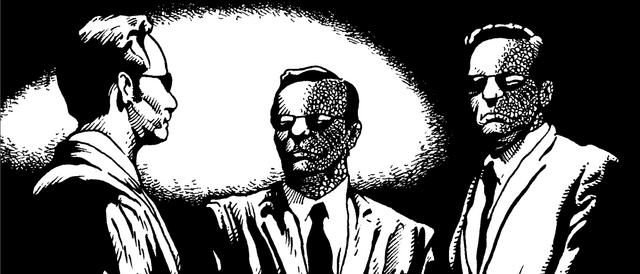
The National Defense Directorate
As the dark mirror of Aegis, Blackbook/NDD is obviously worthy of a section unto itself, and it does in fact have one right here. While it may seem like going from Operation Pigeon Shoot to alien collaborator is a massive leap, it's ultimately all still in the name of humanity: the NDD genuinely believes (or at least believed) that it's smart enough to exploit the extraterrestrials and use their knowledge and technology for humanity's benefit. The Grays were the first alien lifeforms the NDD made contact with, from whom agents learned a great deal about psychic power and the Gray species. In exchange, the Grays have been allowed to abduct people for research, and sometimes even given people kidnapped by the NDD personally. Grays are fairly distant, however; for actual camaraderie of sorts, one has to look to the Saurians.
A specific subspecies of Saurian that call themselves the Gna-Tall met the NDD in the 1950s, forging an alliance and aiding in the construction of a massive underground base known as Dulce Base near Dulce, New Mexico. The NDD gained access to powerful Saurian technology and Gna-Tall agents in human guise (the infamous Men in Black), the Gna-Tall gained knowledge of the human species and access to its military-industrial complex, and both groups grew to have a sort of band of brothers mentality toward each other. While they won't necessarily stick out their necks for each other if it means getting killed for it, individual NDD agents and Gna-Tall soldiers do have respect for one another. This interspecies coalition and the fact that the NDD can cover its tracks under the pretense of the National Security Act make up for the fact that it is more loosely organized than Aegis's tightly-controlled cells.
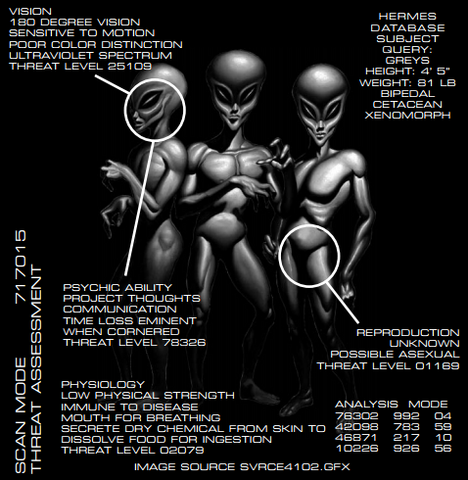
This image is technically from GURPS Conspiracy X, not Conspiracy X Second Edition, but I don't care because I love the goofy framing device.
Grays
Grays (spelled Greys throughout, but my stupid American fingers refuse to remember to repeatedly type that) are short (around 4'5") humanoids with rubbery gray skin, five fingers and two toes, bulging foreheads, and huge jet black eyes. Their mouths are entirely vestigial, the roles of communication and feeding being performed by psychic communication and filter-feeding through the pores of their skin respectively. They evolved on an aquatic world where psychic energy was not only even more intense than it is on Earth, but also more refined and controlled, with no Seepage existing there. They are innately exceedingly talented at all forms of psychic powers (with the exception of precognition, which is a uniquely human and Seepage-associated phenomenon) and are much more precise in their actions than a human psychic of the same power level. Most infamously, Grays have the "time loss" power, wherein targets undergo a complete sensory blank that destroys all sense of the passage of time for the duration of the power. This is usually either a defensive maneuver or utilized during abductions.
Grays are described as "aviolent" beings: they won't attack you, but they also don't give a shit about collateral damage or unintended consequences of their actions, such as the inevitable crash from doing a mental blank on someone driving a vehicle. Grays similarly don't like confrontation or conversation, and may even become angered if you attempt to communicate with them. If the species has any form of national identity, religious ideology, or unique divisions amongst themselves, both Aegis and Black Book don't know about them. The only concrete knowledge of just what makes Grays tick is that they seem to be akin to morally bankrupt Victorian explorers, finding and picking up Earth entities for research without a huge amount of concern for their well-being. As far as their relations with other species go, none of them have gone particularly well. They are ambivalent about humans, avoid Atlanteans due to violent conflicts between the two species in the past, and are scared shitless of the aura of menace they pick up from Saurians and will flee from them whenever the two meet.
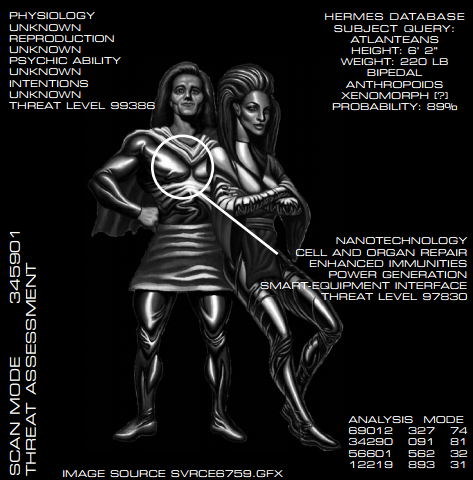
Atlanteans
The quintessential Ancient Astronauts, Atlanteans resemble perfected humans who ooze style, grace, and confidence (nobody told that to the two hairdo nightmares above, apparently). They are a species of extreme individualists, having become so entangled with their own perception of individual perfection after their civilization fell to some manner of ruin of their own machination that single Atlanteans either decided they were gods unto themselves or could no longer trust others of their kind. Almost all ply the stars alone in search of meaning and purpose, and this lack of a unified goal means what little Aegis has gleaned about "Atlantean activities" is wildly contradictory. There is no grand design, no master plan – and that's what makes them the most frightening to both secret agencies.
Atlanteans rely heavily on their highly advanced nanotechnology. This technology has allowed Atlanteans who were around when modern humans first developed to still be alive and kicking, as well as engage in a myriad of miraculous and seemingly magical actions. They are both creative and exceedingly vain, crafting their personal tools as unique art pieces and never going so far as to let their numerous cybernetic augmentations (in their minds) mar their appearance. As far as interspecies relations go, Atlanteans are usually pretty aloof. Humans are seen as interesting but ultimately nonthreatening lifeforms to be used as either toys or tools, with Saurians coming in a close second as a harmless curiosity to be learned more about but not interacted with directly. Grays, however, are a big problem. Atlanteans are always Psy Voids, and the Grays' depths of psychic knowledge and FTL travel actively offend the Atlanteans' belief that they completely understand the physics of the universe. Just what this leads to varies from Atlantean to Atlantean: some attempt to copy the Grays' abilities, others just avoid the question altogether and try not to think about it too hard, and some actively engage in violence against the psychic species.
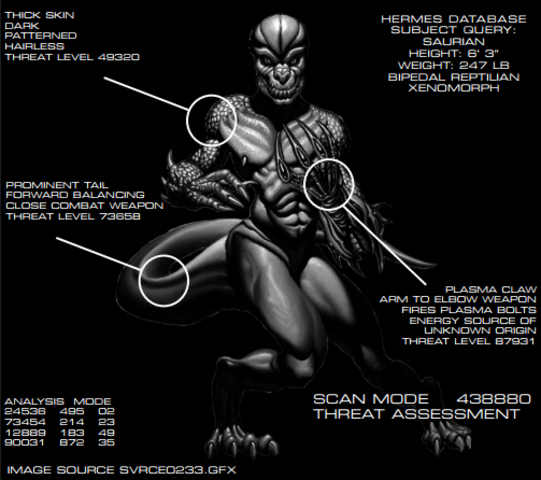
Saurians
The Saurians that are actively known by Aegis and work alongside Black Book are the Gna-Tall, a race of big bipedal lizards with a literal inbred need for violence. Their brutal society is one wherein communities are a "family" led by a feudal lord, with the families being on a hair trigger with one another at any time they aren't already in open war. The Gna-Tall actively work with Black Book to spur on the US military-industrial complex, spoonfeeding tidbits of their advanced technology in order to enhance the human war machine. The two most famous Saurian inventions utilized by Black Book area the TD-121 (basically a knockoff Aurora III, with slightly greater speed but no psychic lens or nanomachines) and the Black Manta (a manta ray-shaped troop transport capable of carrying up to twelve fully equipped Black Book soldiers and armed with a 20mm ECM cannon). In spite of their highly developed particle physics knowledge, however, Saurian science lags slightly behind that of humanity in the biological sector, and humans' capabilities at genetic testing and biological warfare startle even these ferocious reptiles.
The big secret about why the Gna-Tall do what they do is one that neither Aegis nor Black Book actually knows about. There are bigger, nastier, and more numerous subspecies of Saurian out there, including the centauroid Croll, four-armed Kath-Yal, and enigmatic Te-Mulys, and they are gunning for Earth and the Gna-Tall. All of that military-industrial complex business is meant to prepare humans to aid the Gna-Tall in the coming Saurian civil war. They have even been willing to compromise their religious belief in the holiness of the natural world and its standard evolutionary course, engaging in the disdained practice of body transmogrification to create the human-shaped Gna-Tall known to Aegis as the Men in Black. Almost all alien interactions the Saurians have are between their clans and subspecies: they don't know about the Atlanteans at all, and their nature as Psychic Voids makes them confident that Grays are insignificant pests that can be offed if one hinders the war effort.
Next Time: With the core rules finished up, I am going to take a hiatus (I know, I know, how's that different from usual?) before covering the poll winning supplement, The Extraterrestrials Sourcebook.